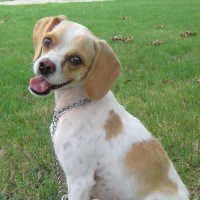Appearance of the Brittany Beagle
|
| The Brittany Beagle is a hybrid between the Brittany Spaniel and the Beagle, and will often have distinctive characteristics of both breeds. Both parent breeds are hunting dogs and are small to medium-sized. This hybrid often has a beautiful Breton coloring of white and orange or roan with a few spots. Larger than the Beagle, your Brittany Beagle will probably have longer, leaner legs than the average Beagle. A Brittany Beagle's tail will probably resemble that of the Brittany Spaniel, which is bobbed or tailless. Brittany Spaniels and Beagles have similar head sizes and expressions, with proportionate muzzles of medium length. Beagle ears are slightly larger than those of the Brittany Spaniel, which will also have long hair on its ears. The Brittany Beagle can resemble either parent, but most closely resembles the Brittany Spaniel in coloring and structure. |
Temperament of the Brittany Beagle
|
| The Brittany Beagle is a gentle, temperate mix. Beagles, known for their mischievous and sometimes boisterous behavior, are great fun but can be difficult to manage, whereas the Brittany Spaniel is an alert, happy and independent-minded breed. The Brittany Beagle's parent breeds make this hybrid an excellent family dog that loves children and is friendly to strangers. The Beagle is a pack breed that won't tolerate being left alone, and despite its independent spirit, the Brittany Spaniel won't tolerate solitude either. A mix of both breeds will need the company of the family to prevent negative behaviors and separation anxiety from developing. The Brittany Spaniel and Beagle breeds are intelligent dogs, sometimes stubborn and very driven by their prey. This can make your Brittany Beagle difficult to train, and this hybrid is not recommended for novice dog owners. Many owners resort to food-based reward methods for training, but be careful as this hybrid tends to put on weight. |
Needs and activities of the Brittany Beagle
|
| The Brittany Beagle is a hybrid of two breeds with similar exercise needs and intensity levels. The Brittany breed is less intense, but still needs at least an hour's playtime a day, including running. Beagles also like to run, and up to two hours is a good amount of time to fully exercise a Beagle. Brittany Beagles do well in all climates, as long as it's not too extreme, but adapting to apartment life can be difficult if your dog leans more towards the Brittany Spaniel. Homes with secure backyards are much more ideal for this hybrid, which requires daily running. |
Maintenance of the Brittany Beagle
|
| The Brittany Beagle is a cross between the moderate-loss Brittany Spaniel and the high-loss Beagle. Chances are your Brittany Beagle will also shed a moderate amount. Brushing your Brittany Beagle frequently will help remove dead and loose hairs from its coat and distribute the skin's natural oils. A Brittany Beagle's skin is loose and moves freely. This will help your Brittany Beagle stay clean and free of larger objects, such as burrs, but frequent brushing will help remove small dirt and debris particles and prevent doggy odors. The Breton parent is prone to ear infections due to the long hair covering the ears. Be sure to check and clean Brittany Beagles' ears with a vet-approved solution to keep his ears healthy. |









 English (United Kingdom)
English (United Kingdom)